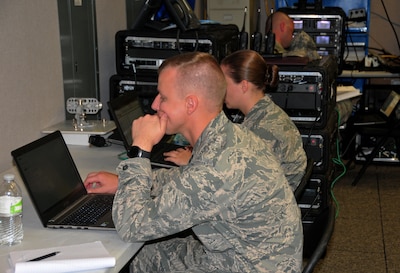By Air Force Capt. Matt Murphy and Air Force Tech. Sgt. Dan
Heaton, Puerto Rico Air National Guard
SAN JUAN, Puerto Rico, Oct. 2, 2017 — Air National Guard
units from Puerto Rico, Illinois and Wisconsin teamed up to restore Federal
Aviation Administration-managed air traffic control operations on Puerto Rico
as part of response efforts in the wake of Hurricane Maria's devastation on the
island.
Maria made landfall in Puerto Rico on Sept. 20 and destroyed
a key generator used by the FAA to power its control center that directs
aircraft movement in and around the island. The FAA's San Juan Center is
responsible for directing the movement not only civilian and military aircraft
for takeoff and landing at the island's airports, but also any aircraft flying
in the vicinity.
"Thanks to our relationship with the Puerto Rico Air
National Guard, they were able to provide us with the assistance we needed to
get back up and running, and now the Air National Guard is supporting us with
redundancy as a backup now that power is restored to our building," said
Edward Tirado, an operations manager with the FAA in Puerto Rico.
Air Traffic Control Curtailed
The loss of power and communications lines required that all
aircraft traffic be controlled by visual and physical spacing. Only one
aircraft could arrive or leave the island every 10 minutes, or six per hour, to
ensure that the aircraft were safely separated. Under normal operating
conditions, an airport the size of San Juan International can handle about 45
flights per hour. The limited aircraft movement choked the supply chain of
critical material and personnel, officials said.
The Puerto Rico Air National Guard, while in a recovery
state itself, saw the big picture and knew they needed to immediately support
the FAA, Tirado said. The focus of the assistance, he said, was to help
re-establish local and ground-to-air communications and to re-establish radar
coverage of the air space above the island and surrounding area.
Air Force Lt. Col. Humberto Pabon, the vice wing commander
of the Puerto Rico Air National Guard's 156th Airlift Wing, said he understood
the gravity of the situation and the necessity to restore air operations
capabilities, so he set teams in motion.
"Our communications flight immediately engaged with the
FAA at the airport to begin that process," Pabon said. "We worked
with various Guard resources to provide power and immediate data link
access."
Restoring Air Traffic Control System
With basic communications re-established, the number of
flights taking place per hour began to climb --
from six per hour to 18 per hour two days after the storm -- to more
than 30 per hour, and finally into the upper 30s and low 40s, which is normal
operations.
After the storm, the wing's 156th Communications Flight had
immediately established a Joint Incident Site Communications Capability team,
giving Air Guard commanders local communications to get their own air
operations back online.
Another Air National Guard JISCC unit, the 126th
Communications Flight from Illinois, is powering the 156th's command post and
airfield management office and restoring ramp operations at Muniz Air National
Guard Base near here.
The Wisconsin Air National Guard's 115th Communications
Flight set up a separate JISCC at the FAA's San Juan communications center.
This allowed San Juan Center to resume having direct communications with
inbound and outbound aircraft.
The commanders and team members from all three JISCCs pooled
resources and knowledge to work with the FAA and get the air traffic control
system back up and running.
"We had to come up with multiple solutions to every
challenge," said Air Force Capt. Jeff Rutkowski, commander of the
Wisconsin Air National Guard's JISCC. "We'd try something and the first
solution wouldn't work. We'd get something started and realize that a better
idea came along, and we'd switch to that.
"We were dealing with a scenario where so many things
were damaged. We really had to get creative," Rutkowski added.
"This support between the guard and the FAA is
unprecedented," said Air Force 2nd Lt. Jose Arroyo-Cruz, a 156th
cyberspace operations officer and one of hundreds of Puerto Rico Air National
Guard members who've been on the job since before the storm hit.
"We had a 'hole in the sky' over Puerto Rico,"
Arroyo-Cruz said. "It was a giant hole in the highway in the sky. We had
to fix that hole before we could bring in aid to the people of Puerto
Rico."









